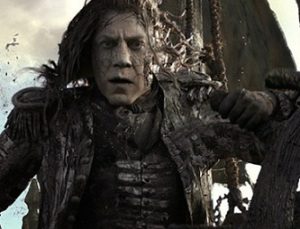
Speaking from his base in England, visual effects supervisor Gary Brozenich divulged his many hurdles on the new Disney sequel Pirates of the Caribbean: Dead Men Tell No Tales. “We did over 2000 shots,” Brozenich said, noting that primary vendor Moving Picture Company created over 1200 of those shots. “MPC was doing the majority of the heavy lifting—the more technically complex work on the show, mostly the creatively complex work too. We all knew what the demand was going to be going into it.”
With artists all over the world working on the film, Brozenich had a 24-hour workflow to complete Dead Men’s detailed dramatic visual requirements. “There were very few hours where I couldn’t jump on the phone with someone,” he said, noting that there were artists simultaneously working in Bangalore, India, plus London and Montreal, with various time zones being a factor.
Additionally, effects vendor The Third Floor created all of the film’s previsualization during the project’s pre-production phase in Los Angeles. Two of the supervisors from The Third Floor went with the production to
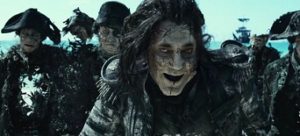
Australia for principal photography. “We were previzing all the way until we started filming,” Brozenich revealed. “We did it for the edit, ongoing into production. That process was handed over in post to do the post-viz—for the shots that they were directly responsible for—to MPC.”
In larger visual effects films such as Dead Men, Brozenich explained, there are many shots where the frame simply features an individual standing against a blue screen with a small part of a ship built by the art department. “They could be exchanging cannon fire with another ship,” he said, indicating the importance of the new advent of post-viz. “Previsualization is moving storyboards, a way to block the film. In post-viz, it’s a tool for the editors and directors to flesh out the cut so that it could be put in front of people who see nothing but blue screen.”
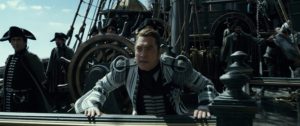
To expand upon the visual treats of Dead Men, the filmmakers also implemented 150 shots fully created with computer-generated imagery. “It’s a fast way for you to experiment when you [place] the camera,” revealed Brozenich, detailing post-viz with CGI. “Four different camera versions, cut between them; pick their best take. Come up with the visual moving narrative of the film before we turn it over for a vendor to work on. It’s a fast way to flesh out the edit. It’s so valuable now—just as much a part of the filmmaking process as previz.”
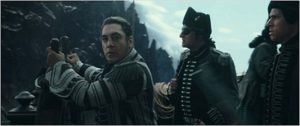
During principal photography, which largely featured two units, Brozenich was always present on set wherever he was most needed. “You’re there to protect the interest of your department on the film and not missing any opportunities,” he unveiled. “We have CG characters and CG birds on one particular ship. There are a lot of digital prosthetics that go onto characters for Javier [Bardem] and his whole crew. He was very interested in what his character looked like. He was able to play into it in a way that made it more fun for us later. They are trapped in a drowned state [with] hair that floats—being able to provide visuals to him and the crew to understand what they [would eventually] look like.”
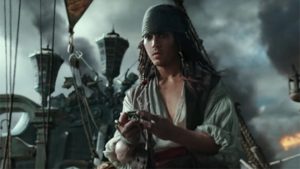
From a technical perspective, considering Bardem’s performance, Brozenich was tasked with merging Bardem’s takes, shot in 24 frames-per-second, with the 96 frames-per-second imagery for Bardem and crew’s floating clothes and hair. Moreover, Dead Men’s story necessitated an enormous amount of computer-generated water work. “The oceans part at one point,” Brozenrich stated. “An unreal event that you try to lend reality to: water backgrounds and being able to mix that with live-action water in a way that’s not distracting. MPC did the vast majority of water work.”
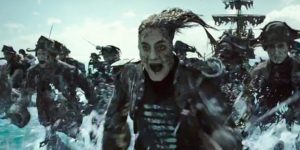
Stationed in Australia for 10 months, which included part of prep, shooting, and visual effects elements, Brozenich relocated to Los Angeles for the majority of post with a total of three years spent on Dead Men—his longest time ever spent on one film. During post, he worked with his many artists in to elevate the novelties in the Pirates series of films. “Referring to the other films, when I saw Davey Jones, it made me want to do visual effects,” he said of the octopus-like character play by Bill Nighy who first appeared in the second film. “So amazingly well done in performance to shot completion. I never went into it with the idea that we were trying to one-up or supersede anything, but to try to retain the spirit from the first film. Trying to give it scope, scale, and a little bit more adventurous fun.”
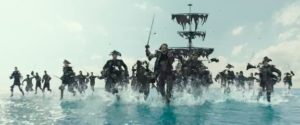
Though the original film, Pirates of the Caribbean: Curse of the Black Pearl (2003), contained only 150 visual effects, Brozenich, after seeing that movie, believed there were many times more effects shots than that, given the blockbuster spectacle that Pirates offered him and millions more viewers. “The impact that it had was so great that I would have put it much higher,” he said.





